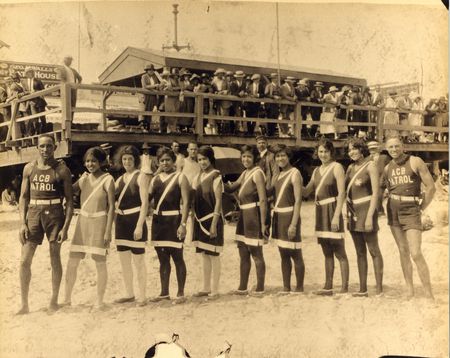
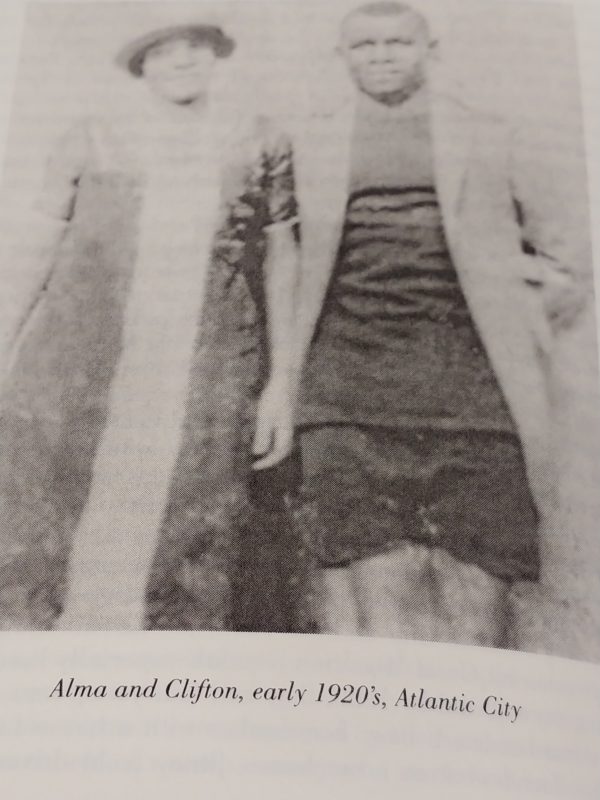
“Atlantic City was the place to be, better than Philadelphia or New York City even. It held the promise of long-term work as waiters, waitresses, cooks, porters, doormen, bellhops, busboys, chambermaids and more, and there was room for advancement in every field, especially for educated Negroes. Ruby Lee and Bobby had told us plenty of coloreds were already buying houses, cars and modern appliances, and owning their own businesses too, right there on the Northside”. Alma Washington describing her first experiences in Atlantic City after joining the “Great Migration” out of the South in 1925. By Turiya S.A. Raheem in Growing Up In The Other Atlantic City. (2009)
NJ Democratic Governor Phil Murphy brought criminal charges against people who protested against his executive orders shutting down their businesses. However, Murphy ignored his own order to be in a Black Lives Matters protest one week later. He justified the unequal treatment by saying “How can you compare a protest to reopen a nail salon, with “a protest against 400 years of racism in America?” That is a Big Lie. The problems of blacks in America today have nothing to do with slavery or racism. They are the logical consequences of the waste, corruption, and mismanagement of massive welfare programs and open borders immigration started by Lyndon Johnson and Senator Ted Kennedy Democrats in 1965.
Most Democrats and our public schools, colleges (like Stockton University), media, and Hollywood and TV pop culture have promoted this same Big Lie for nearly 50 years. Their purpose is clear. Distract both black and white Americans from how they ruined the lives of so many blacks in America today.
My “Boomer” generation knows the truth. We know that America was truly great because we saw it ourselves. We also heard of the many obstacles and challenges our parents and grandparents faced and overcame before they lived the American Dream. Today’s Democrats are not only attacking and demonizing Trump. They are also attacking and demonizing our entire “Boomer” generation. And our parents and grandparents. And virtually every person of European descent who lived during the past thousand years.
Those of us who remember when, how, and why America was great are like Holocaust survivors. We must tell our stories and teach the truth to the next generations while we are still alive. Otherwise, they will never know. Please take the time to read each of the 15 stories below. Try to find some way to teach each of them, one by one to someone you know in the next generation. Then I ask you to tell a 16th story–the story of how you and your family overcame obstacles to live the American Dream.
I am not a professional historian. What I have written below is from memory and quick online research. That research is now difficult because search engines like Google, Yahoo, and Microsoft removed or buried many reliable sources of information that I relied on just a few years ago, when I was an adjunct professor at our local community college. I invite you to contact me if you see any information you believe to be inaccurate. I also invite you to advise me of documents that support information you agree with, so I can cite them as sources. Thanks.
Seth Grossman, Executive Director
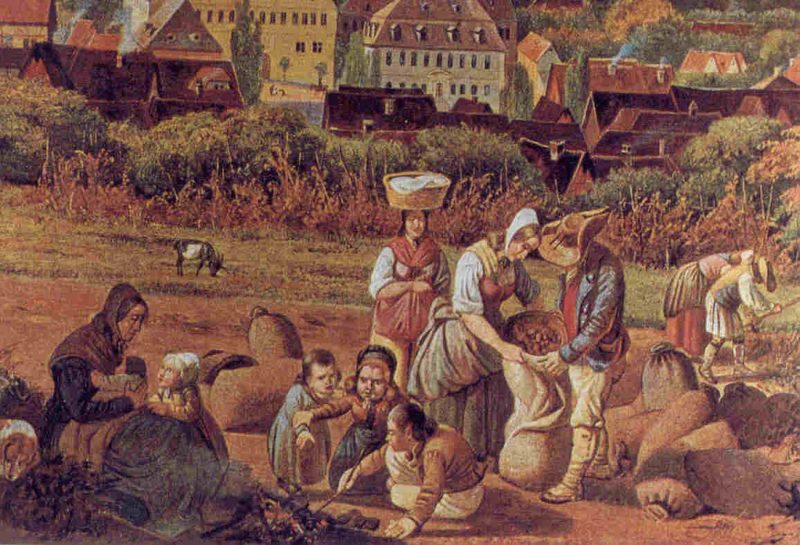
- Jews and Christians ended slavery in most of Europe and the Middle East (then part of Byzantine Empire) more than a thousand years ago (900AD- 1000AD). Until then, slavery was a normal part of life in almost every civilization in the world. Slavery continued unchanged in China, India, Africa, Persia, and in Aztec Mexico.
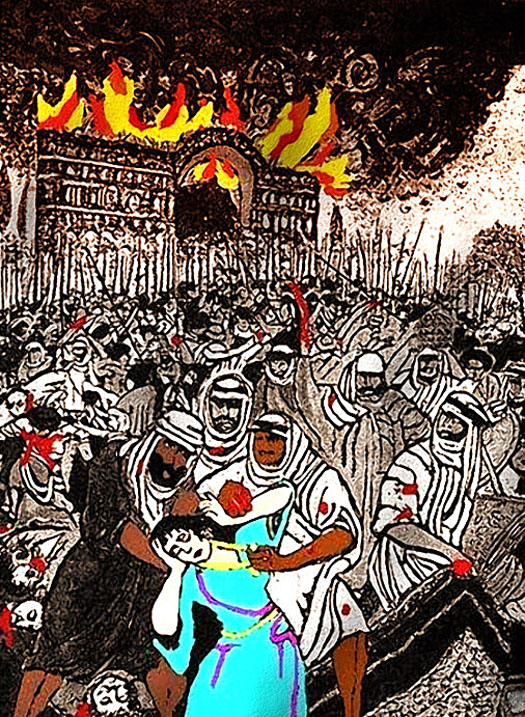
Fall of Ctesiphon, then capital of the Persian (Sasanian) Empire during the Arab/Muslim Invasion and Occupation of 638 AD. Muslims destroyed and occupied the entire Persian Empire, and conquered two thirds of the Byzantine (Eastern Roman) Empire including what is now Egypt, Israel, Syria, Lebanon and Palestine in less than 30 years.
- Muslims (followers of the Prophet Muhammad) greatly increased and expanded slavery and brought it back to the Middle East. When Muhammad died in 632, his successors taught that every Muslim had a personal obligation to do whatever he or she could to achieve the goal of making every person in the world a follower of the Prophet. The struggle to do this was called “jihad” (holy war). Those who waged jihad by battle were called “mujahideen”. They were richly rewarded. Those killed in fighting were instantly forgiven for all their sins and given eternal life in paradise with all the women they wanted. Those who survived were entitled to a share of whatever wealth was captured, including men, women, and children taken as slaves. During the next 120 years, Muslims conquered some 50 million people. They destroyed and occupied the entire Persian (Iranian) Empire. They conquered two thirds of the Byzantine or Eastern Roman Empire including Egypt and most of the Middle East. They did this in less than 30 years! During the next 90 years, they conquered much of India and the rest of North Africa including what is now Tunisia, Algeria, and Morocco. They also conquered Portugal and most of Spain in Europe. This began their 500 year “Golden Age of Islam”. It was built on the wealth and slaves they captured. Their “Golden Age” ended when they could no longer conquer new advanced civilizations.

The Arabic words “abd” and “abid” mean “slave” and “slaves”. However, in many Arab countries, those words also refer to any black African in a derogatory way.
- When their conquests slowed after 750, the Islamic world needed fresh supplies of slaves. Most new slaves were blacks taken from below the Sahara Desert in Africa. Muslim raiding ships and caravans captured or purchased new slaves from East Asia, India, sub-Sahara Africa and Christian Europe. However, most were blacks from Africa. Most were brought to slave markets in Morocco and the Mediterranean ports of Algiers, Tunis and Tripoli in North Africa. This area later became known as the “Barbary Coast”. Others were brought to Egypt or Zanzibar. The Arabic words for slave and slaves are “abd” and “abeed”. In much of the Arab world today, those same words also describe any black African in an insulting manner. The Muslim slave trade was far more massive and brutal than anything ever done by Europeans. It also lasted much longer. According to Nigerian scholar Adamu Kyuka Usman in his book “Theory and Practice of International Economic Law” at page 222:
“The mortality rate for slaves shipped across the Atlantic Ocean was 10%. The percentage of slaves that died in transit in the Arab slave trade was as high as 80 and 90 percent. . . Most of the male slaves destined for the Middle East were castrated, and most of the children born to the women were killed at birth. It is estimated that as many as 11 million Africans were transported across the Atlantic. . . only 5% went to the United States. At least 28 million Africans were enslaved in the Middle East. Since at least 80% of slaves shipped to the Middle East died in transit, the death toll in the 14 centuries of Arab slave trade could be as high as 112 million slaves. While there were European slave trade abolitionists, there were no such abolitionists in the Arab world. Nearly a hundred years after Abraham Lincoln issued the Emancipation Proclamation in America. . . Saudi Arabia and Yemen, in 1962, and Mauritania in 1980 removed legalized slavery from their statute books”.
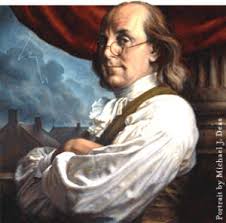
Benjamin Franklin forcefully and consistently urged Americans to abolish slavery as soon as their fight for freedom against with England began. He mocked those who justified making slaves of black Africans, while being outraged when Muslims attacked and enslaved Christians. Franklin’s influence helped make Pennsylvania the first of the 13 states to abolish slavery in 1780.
4. Many, if not most whites in America opposed keeping blacks as slaves since our War for Independence began. As Abraham Lincoln said in 1861, our Declaration of Independence on July 4, 1776 did far more than “separate the colonies from the motherland”. It also declared that “all men” were “created equal and endowed by their Creator with certain unalienable rights”. They included “liberty”. Many Americans, including George Washington, were shocked by how many slaves ran away to join the British who offered them freedom in Virginia in 1775. Benjamin Franklin forcefully and consistently spoke out against slavery. Franklin supported Quakers and others who made Pennsylvania the first state to abolish slavery in 1780. By 1787, four other states abolished it. Two more, New York and New Jersey soon followed. In 1787, Congress abolished slavery in the “Northwest Territories” that included the future states of Michigan, Ohio, Indiana Illinois, and Wisconsin. The Constitution of 1787 allowed Congress to stop the importation of new slaves in 20 years after ratification, and this was promptly done in 1808. George Washington and many slaveowners in Virginia either freed their slaves, or made wills freeing their slaves when they died. Before he ran for President, Abraham Lincoln studied the letters, notes, and voting records of the 39 “founding fathers” who framed and signed our Constitution in 1787. In his famous “Cooper Union Address” of February 27, 1860, Lincoln reported that 23 of the 39 framers of our Constitution, a clear majority, opposed slavery and framed the Constitution to promote its “ultimate extinction”.

- When America won independence in 1783, the Barbary Coast slave states declared war on America. Their slave raiding “privateers” or “corsairs” attacked and seized our ships. They seized the cargo and threatened to sell all passengers and crew members into slavery if we did not pay bribes or ransom. In 1785, John Adams and Thomas Jefferson met their ambassador in London to find out why. The Barbary ambassador gave this explanation: “It is written in our Koran, that all nations which have not acknowledged the Prophet are sinners, whom it was the right and duty of the faithful to plunder and enslave”. Since America did not yet have a Constitution, a President, or a navy, Congress ordered Adams and Jefferson to pay the bribes and ransoms needed to stop the attacks. For the next 15 years, these payments were roughly 10% of the federal budget. Later, when Adams and Jefferson each became President, America built a navy and went to war to stop the attacks. Richard Somers of Somers Point was a hero in that war. He died by “the shores of Tripoli” on September 4, 1804. Each year, a ceremony is held in Somers Point to remember him and tell his story. Later our new navy worked with other European nations to completely end the Barbary Coast slave trade by sea in a second war in 1815. However, the Islamic slave trade continued on land and in the Indian Ocean. It did not completely end until 1980 and may still exist in certain remote areas.

“To the Victors Belong The Spoils”. 1829 political cartoon by Thomas Nast mocks Andrew Jackson and the Democratic Party he formed by combining groups of slave traders and slave owners in the South with the corrupt “Albany Regency” political machine of New York.
- Most Americans were surprised and disgusted when previous restrictions did not put slavery “in the course of ultimate extinction” as expected. The invention of the cotton gin in America in 1793, and new machines to mass produce cotton fabric in England suddenly changed everything. They made growing and processing cotton with slave labor far too profitable to resist. “King Cotton” let poor whites with no skills buy slaves and cheap land in Georgia, Alabama and Mississippi with easy credit, have slaves clear the land and plant and pick the cotton, and be wealthy beyond their dreams within a year. “Cotton made a poor man rich and a rich man a king”. Mississippi, Alabama, and Georgia quickly became the richest states in America. There was also easy money in the slave trade. Slave traders with no conscience got rich buying slave families cheaply in Virginia and Kentucky where slavery was becoming unprofitable, and selling just the young and healthy “down the river” to clear new cotton fields. Easy money, not racism, revived and expanded slavery in America. It also poisoned American politics. A Tennessee war hero named Andrew Jackson was one of the poor white men who quickly got rich from slavery and the slave trade. In 1828, Jackson formed a political alliance with Martin VanBuren, who led a powerful, corrupt, “pay to play” political machine in New York known as the “Albany Regency”. Together, they formed a new “Democratic Party”. This new Democratic Party won control of the White House, Congress, and most state governments from 1828 to 1840. The Democratic Party appealed to poor young men who wanted to get rich quick. The “Albany Regency” politicians of New York supported Andrew Jackson when he made cheap land available for cotton and slaves in Georgia, Alabama, and Mississippi by breaking treaties, and illegally removing Native Americans. Andrew Jackson and his supporters in the South fired all government employees and appointed friends of New York’s “Albany Regency” to top positions. When Andrew Jackson was criticized for this, he answered, “To the victors belong the spoils”. Democrats also gave charters to numerous banks that freely loaned to supporters who were unable to repay them. This led to an economic collapse that began in 1837. In 1834, a group of politicians from around the country formed a new political party to oppose Democrats led by “King” Andrew Jackson. They named their new party “The Whigs” after a political party in England that opposed the King. An early member of the Whig Party was Davy Crockett, a Tennessee frontiersman and former friend and supporter Jackson. Crockett turned against Jackson when Jackson broke treaties and supported the illegal removal of Native Americans from their lands. Another was Illinois lawyer Abraham Lincoln. In 1854, Lincoln joined with other Whigs around the country to form a new “Republican Party” opposed to slavery.
The popular 1856 song “Nelly Gray” expressed the anger of many northern whites against slave traders like Andrew Jackson who broke up slave families in the “Old South” of Virginia and Kentucky . They sold only the youngest and strongest “down the river” to do the deadly work of clearing forests and draining swamps for new cotton fields in Georgia, Mississippi and Alabama. Although still a bluegrass favorite, Nelly Gray is usually played as an instrumental because of its inflammatory lyrics.
- Most white Americans outside the South actively opposed the growth and expansion of slavery into new territories west of the Mississippi River. In 1820, they opposed admitting Missouri as a slave state. They reluctantly agreed only as apart of a “Missouri Compromise” to keep slavery out of most other territories. When the power and wealth of slave owners continued to grow, whites outside the South began demanding the complete abolition of slavery. In 1831, William Lloyd Garrison published an influential “abolitionist” newspaper called “The Liberator”. Many church leaders preached that Leviticus 25:11 from the Old Testament (which is inscribed on the Liberty Bell in Philadelphia) required slaves to be freed in “the fiftieth year”. The fiftieth year after the adoption of the U.S. Constitution was 1837. Two other events in 1837 also increased opposition to slavery outside the South. One was America’s most severe economic collapse, which caused widespread hardship. The second was the murder of the publisher of an anti-slavery newspaper in St. Louis, Missouri, by a pro-slavery mob. In 1851, a preacher’s daughter named Harriet Beecher Stowe wrote a novel and play called “Uncle Tom’s Cabin” which dramatized the evil of slavery. It brought opposition to slavery and hatred for slave owners, slave traders, and bounty hunters who tried to capture and return run-away slaves in the North.
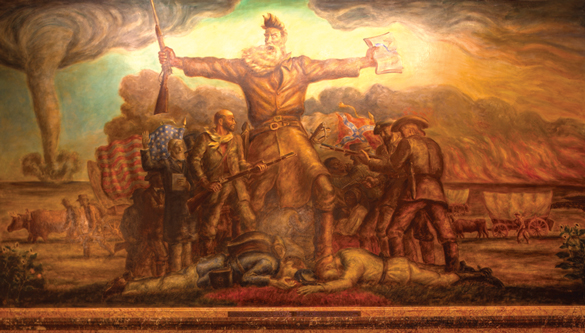
“Tragic Prelude” mural of John Brown at Kansas Statehouse. Although often portrayed as a madman with Bible in one hand and rifle in the other, John Brown and other abolitionists pursued a successful strategy to end slavery in America. John Brown helped stop the expansion of slavery by fighting to keep it out of new territories that would later become states. Others made slavery unprofitable and unsustainable in “border” slave states. They did it by organizing large, systematic escapes of slaves there with “underground railroads”. Seven southern slave states tried to secede in 1861, triggering the Civil War. They did it when most whites in the North voted for Republican Abraham Lincoln who supported those strategies.
- For twenty-three years before the Civil War began, most whites outside the South took part in a relentless and often violent war of attrition to make slavery unprofitable and unsustainable. They aggressively kept cotton and slavery out of federal territories so that there would not be new slave states. By 1860, free states outnumbered slave states. At the same time, northern whites set up “underground railroads” to help large numbers of slaves escape from Virginia, Delaware, Maryland, Kentucky, and Missouri. They also aggressively stopped slaveowners from capturing and returning runaway slaves. This made slavery unprofitable and unsustainable in many parts of the “border” slave states. Since most planters bought slaves on credit, banks as well as slaveowners lost money every time a slave escaped. In 1858, Abraham Lincoln gave his “House Divided” speech in which he warned that America could not continue to exist “half slave and half free”. In 1859, John Brown tried to start a slave rebellion when he thought this war of attrition was not moving fast enough. When Lincoln was elected in 1860, seven slave states adopted resolutions removing themselves from the United States before he took office. Each of those resolutions openly stated why they were leaving the United States. They were convinced that the rest of America would force them to abolish slavery if they did not. Source: Border War: Fighting Over Slavery Before The Civil War, Stanley Harrold, 2013.
This 1860 Republican campaign song for Abraham Lincoln, like Lincoln himself, felt that our Declaration of Independence did much more than “separate the colonies from the motherland”. “Success to the old-fashioned doctrine, that men are created all free!”
- There is no doubt that widespread opposition to slavery in the North caused the Civil War. The resolutions of secession for all eleven Confederate slave states confirm that. So do all official and newspaper reports of speeches and debates at the time. The most popular and inspiring songs of the Civil War confirm this. They include Lincoln and Liberty Too, John Brown’s Body, Battle Hymn of the Republic, Battle Cry of Freedom, Kingdom Coming (Year of Jubilo) and Marching Through Georgia.
“We welcome to our ranks, the loyal true and brave, shouting the Battle Cry of Freedom. Although he may be poor, not a man shall be a slave. . . ” The music of this song is the background to our Libertyandprosperity.com radio messages.
Abraham Lincoln’s best known speeches recognized that opposition to slavery caused the Civil War.
In his speech at Gettysburg on November 19, 1863, Lincoln said:
“Four score and seven years ago (In 1776) our fathers brought forth on this continent, a new nation, conceived in Liberty, and dedicated to the proposition that all men are created equal. Now we are engaged in a great civil war, testing whether that nation, or any nation so conceived and so dedicated, can long endure. . .”
In his second inaugural address on March 4, 1865, Lincoln said,
“One eighth of the whole population were colored slaves, not distributed generally over the Union, but localized in the Southern part of it. These slaves constituted a peculiar and powerful interest. All knew that this interest was, somehow, the cause of the war. To strengthen, perpetuate, and extend this interest was the object for which the insurgents would rend the Union, even by war; while the government claimed no right to do more than to restrict the territorial enlargement of it. . . Both (parties) read the same Bible, and pray to the same God; and each invokes His aid against the other. It may seem strange that any men should dare to ask a just God’s assistance in wringing their bread from the sweat of other men’s faces; but let us judge not that we be not judged. . . The Almighty has his own purposes. ‘Woe unto the world because of offences! for it must needs be that offences come; but woe to that man by whom the offence cometh!’ If we shall suppose that American Slavery is one of those offences which, in the providence of God, must needs come, but which, having continued through His appointed time, He now wills to remove, and that He gives to both North and South, this terrible war, as the woe due to those by whom the offence came, shall we discern therein any departure from those divine attributes which the believers in a Living God always ascribe to Him? Fondly do we hope–fervently do we pray–that this mighty scourge of war may speedily pass away. Yet, if God wills that it continue, until all the wealth piled by the bond-man’s two hundred and fifty years of unrequited toil shall be sunk, and until every drop of blood drawn with the lash, shall be paid by another drawn with the sword, as was said three thousand years ago, so still it must be said ‘the judgments of the Lord, are true and righteous altogether’.”
10. Roughly 2.1 million soldiers and sailors fought for the Union in the Civil War. Roughly 1.9 million or 90% were white, and nearly 200,000 or 10% were black. Roughly 310,000 of whites and 40,000 blacks died from battle or disease. Throughout history, many people fought and died to free themselves from slavery. Yet never before in history did any nation make such enormous sacrifices to free another people from slavery.
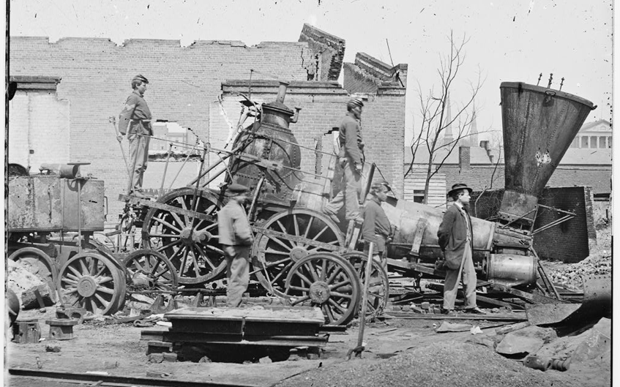
Destroyed locomotive, Richmond Virginia, shortly after occupation by Union troops. As with Atlanta, Richmond was accidentally burned by Confederate soldiers destroying unused ammunition they could not take with them before retreating.
-
- America is rich today in spite of slavery, not because of it. As Abraham Lincoln observed in his Second Inaugural Address, the Civil War destroyed far more wealth than anything gained from the enslavement of blacks. Besides losing the lives of 350,000 young men, the North spent roughly $3.4 billion in 1860 dollars on the war. Besides losing 250,000 men, the South spent roughly $3.3 billion. In addition, the South incurred damages of roughly $1.5 billion in 1860 dollars from the destruction of many of its railroads, bridges, factories, and other buildings. That included the almost total destruction of cities like Vicksburg, Atlanta, Columbia, and Richmond. The three richest states in America before the Civil War, Mississippi, Alabama, and Georgia were among the poorest after the war. Sources Include: The Economic Cost of the American Civil War: Estimates and Implications. C. Golding, F Lewis. The Journal of Economic History, June 1975.

12. The KKK was created by white Democrats in the South to regain political control after losing the Civil War. They terrorized and murdered white Republicans (who they called “carpetbaggers” and “scalawags”, and blacks who at that time voted straight Republican. When Republican Abraham Lincoln was murdered by a Democrat celebrity actor in 1865, his Democratic Vice-President Andrew Johnson did little or nothing to stop the KKK. Republicans in Congress impeached Johnson in 1868, but the Senate failed by one vote to get the two-thirds vote needed to remove him. That changed when Republican President Ulysses Grant was elected and took office. For the next eight years, President Grant used federal troops and the support of local blacks and Republicans in the South. During this time, the KKK was crushed. However, in the election for President in 1876, white, southern Democrats joined with the big Democratic political machines in New York to win the popular vote. However, 20 electoral votes were disputed and neither candidate had a majority. After months of crisis, a compromise was reach to avoid another civil war. Democrats agreed to let Republican Rutherford B. Hayes become President. Republicans agreed to remove federal troops from the South. This allowed white Democrats to suppress black voters and regain political control of the eleven former Confederate states. Those eleven southern states almost always voted solidly Democrat for the next 88 years and became known as the “Solid South”. During that time, no Democratic Party candidate for President could get nominated or elected without their support.

Sarah Spencer Washington was born in West Virginia, but moved to Atlantic City where she opened a small hairdressing salon on Baltic Avenue in 1913. When she could not find beauty products suitable for African American hair and skin, she took chemistry courses at Columbia University and developed her own products. She formed Apex Beauty Supply and published a magazine. She was a multimillionaire within ten years.
-
- Between 1870 and 1930, roughly two million blacks moved out of the South. This movement was known as the “Great Migration”. Most found opportunities, freedom, prosperity and safety in cities in the North and Midwest. The prejudice and discrimination they found there was much less than in the South, and similar to that faced by Jews, Italians, and other new immigrant groups. It was normally overcome through education, work, discipline and patience. One horrible exception was occasional violence instigated by white Democrat political leaders who felt threatened by large numbers of black voters who then voted for Republicans. Much of the violence was triggered and enabled by the racist, fake-history Hollywood movie Birth of a Nation released in 1915. Its purpose and effect was to re-elect “progressive” Democrat President Woodrow Wilson in 2016. Opportunities and incomes for blacks greatly increased after World War One and new immigration laws restricted the number of new immigrants competing for jobs. In 1917, blacks who earned 75 cent a day in the South could earn up to $4 per day in factories and railroads in the north. Many blacks who moved north were educated teachers, lawyers and social workers. Many were successful in business and entertainment. They included Atlantic City’s Sarah Spencer Washington who opened a small beauty salon on Baltic Avenue, but who became a millionaire several years later developing and marketing beauty products for African-Americans. They also included composers and entertainers like James Europe, Noble Sissle, and Eubie Blake who were part of the “Harlem Renaissance” that produced mainstream productions like “Shuffle Along”. However, there were many stories of many ordinary people. One of them was the story of Clifton and Alma Washington who arrived in Atlantic City in 1925, as told by their granddaughter S. A. Raheem:

“I think we knew we were a tad bit afraid back then. We were oblivious to the colored sunbathers congregating on blankets and towels and in the surf all around us. As the sun crept higher into the sky, we hurried back over the hot sand to where we’d started and headed toward the boarding house. That’s when we looked back and realized how many colored people were on the beach and in the water.
“When we reached the Boardwalk promenade, we were astonished to find throngs of people, young and old, coloreds and whites, families, singles and couples, all immersed in various types of entertainment. . .
“Atlantic City was the place to be, better than Philadelphia or New York City even. It held the promise of long-term work as waiters, waitresses, cooks, porters, doormen, bellhops, busboys, chambermaids and more, and there was room for advancement in every field, especially for educated Negroes. Ruby Lee and Bobby had told us plenty of coloreds were already buying houses, cars and modern appliances, and owning their own businesses too, right there on the Northside. As we walked home, it was clear to us that this city could not survive or progress without our community, and Cliff and I aimed to get a piece of this American dream too.“ Alma Washington. Source: Growing Up in the Other Atlantic City, Turiya S. A. Raheem (2009) Pages 20-21.

In 1916, Atlantic City dedicated this Civil War monument at Providence and Atlantic Avenues. Thousand of blacks and whites attended, including many black and white Civil War veterans. Blacks also celebrated their progress and achievement after leaving the South during the “Great Migration”. Tragically, years of progress were almost instantly erased by the hateful Hollywood propaganda movie “Birth of a Nation” released the previous year.
-
-
- Blacks in northern cities often faced insults and discrimination. However, so did Jews, Italians and Irish immigrants, and “hayseeds” from farms who also just arrived. What made these cities in America different from the Old Country and the South, was that insults by ignorant people could be ignored and forgotten and discrimination could be overcome. In northern cities, polices and courts, judges and juries almost always equally protected the lives, liberty and property of all citizens. In the North, almost everyone with talent, determination, and discipline could succeed and did succeed. It appears that the “Black History” taught by schools, the media, and Hollywood and TV entertainment teaches only the most extreme racism experienced by blacks in the South, and ignores the opportunities and progress in the North after the “Great Migration”. “Black History” also fails to teach of the prejudice, discrimination, and obstacles faced by most whites at the same time, and how whites struggled to overcome them. That has given far too many black Americans the false idea that whites succeeded because of “privilege” and that only blacks faced prejudice and discrimination.
-
https://www.youtube.com/watch?v=u9y0SlwDNOs
Every hateful, ugly, fake caricature of Republicans and black Americans was presented as fact in the hateful propaganda movie Birth of a Nation in 1915. Southern whites were portrayed as helpless victims. This three hour movie changed national attitudes and public opinion overnight. It was effective not just because of its brilliant and graphic images, but because it used historically accurate settings of well known events. It also often quoted “progressive” Democrat President Woodrow Wilson’s book “History of the American People” written when he was a professor at Princeton University. Nazi Propaganda Minister Josef Goebbels was so impressed with the propaganda success of this film that he later used it as a model for movies made to promote hatred of Jews in Nazi Germany.
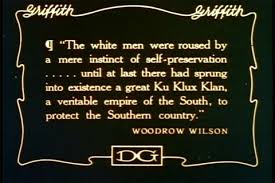
Use of quotes by then President Woodrow Wilson gave credibility to the most outrageous lies and fake history contained in “Birth of a Nation”.
15. The long dead KKK was revived and expanded nationwide by the Hollywood fake-history propaganda movie Birth of a Nation released in 1915. It falsely presented the most hateful and ugly caricatures of blacks as documented, historical facts. It glorified the KKK and justified hate and violence against blacks and Republicans. Many at the time sadly observed that in three hours, this one movie erased and destroyed fifty years of enormous progress and achievement by freed black slaves and their children and grandchildren. That movie was based a novel called The Clansman written by a college friend of racist southern Democrat Woodrow Wilson before he became President. Both the novel and the movie often quoted fake “facts” contained in Wilson’s pro-Confederate history book “History of the American People” written while Wilson was a professor at Princeton University in New Jersey. That movie helped Wilson win re-election in 1916 by suppressing the black vote, which was then overwhelmingly Republican and winning sympathy for southern white Democrats. The movie was such effective propaganda that Nazi propaganda minister Joseph Goebbels later used it as a model for his hateful propaganda movies against Jews.
In 1920, Republicans won landslide victories against Woodrow Wilson Democrats (including Vice Presidential candidate Franklin D Roosevelt) in the elections by promising a “return to normalcy”. During the 1920’s, blacks outside the South in America enjoyed unprecedented success and prosperity. Republican Presidents and Governors crushed the KKK outside the South. However, many of the lies and hatred created by Birth of a Nation, and angry reaction to them, became imbedded in our culture and are still with us today.
16. The final, and most important story your children need to hear is your story. What brought your family to America? Or from the country to the City? What discrimination and other obstacles did they face? What did they have to do to live the American Dream? For the past thirty years, I attended dozens of funerals for the parents of friends and family members. Regardless of race, religion, or ethnic group, the eulogies told almost identical stories. The deceased came to New Jersey with almost nothing. He or she faced poverty and discrimination. He or she had to work and save and get an education. He or she lost almost everything during the Depression and/or the War. He or she went back to work, got married, and gave his or her children a better life. I wish I took a video of every eulogy and could show it today. However, you need to tell the story of your family to your children and grandchildren, nieces and nephews–while you can. Below are some of the stories of my family told to me by my parents and grandparents. This is the story I told my children.
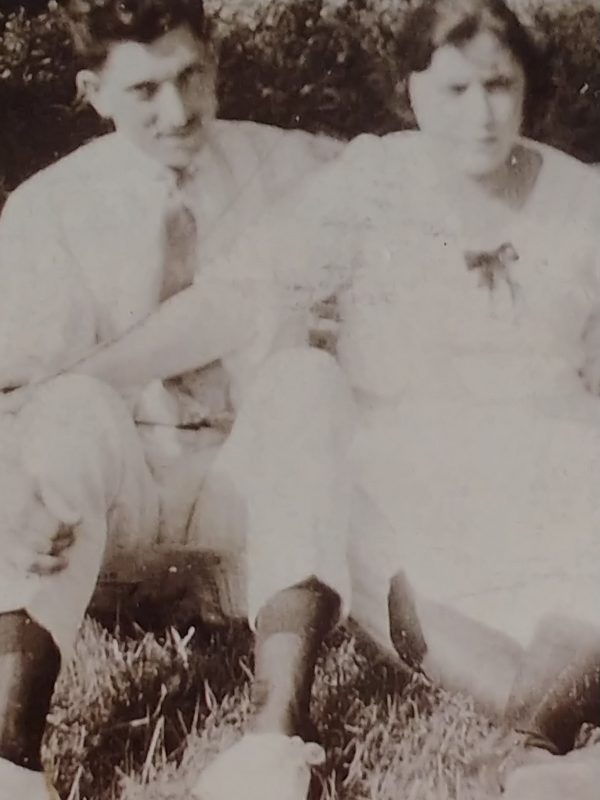
(Above, Max and Betty Shapiro, early 1920’s) My mother’s father, Max Shapiro, was brilliant at math and always wanted to be an engineer and design buildings and bridges. He graduated Cooper Union engineering at the top of his class. However, he could not find employment because the major engineering companies in New York refused to hire Jews. He went back to school to become a dentist so he could support a family and get married. When he set up a successful practice, he married my mother’s mother, Betty Cohen and they had three children. This photo probably taken in Catskill Mountains in early 1920’s. Seth Grossman
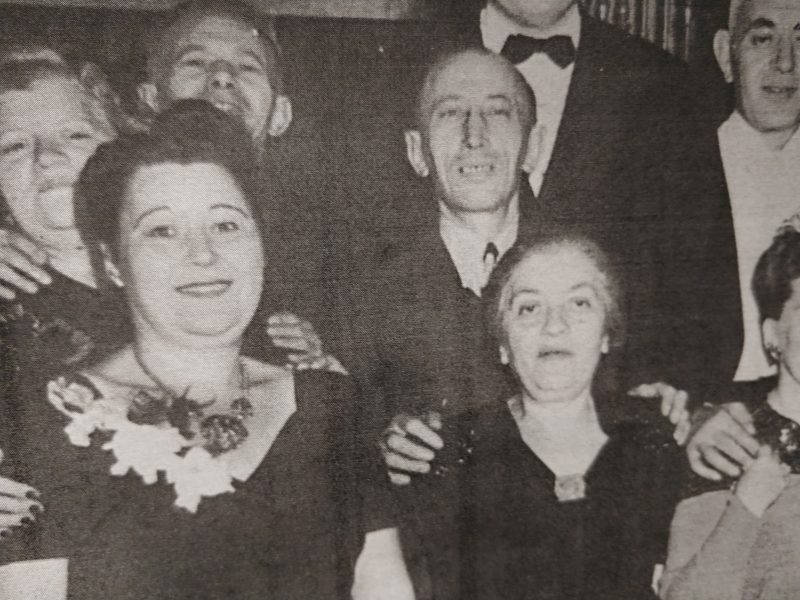
(Above, part of photo of my father’s parents) My father’s father, David Grossman is in the middle, holding my father’s mother Annie, somewhere in Brooklyn, New York in the mid to late 1930’s) To the left is his brother Sam, and on the extreme right, out of the photo is his other brother Philip. I don’t have a lot of cousins, because those three Grossman brothers married three Friedman sisters. My grandfather came together with Philip as teenagers with a gold coin, and some copper coins in the early 1900’s. However, he was tricked out of the gold coin shortly after he landed in Manhattan. He and Philip had nothing, and had to find work right away to eat. My grandfather worked in a sweatshop fabric factory in Manhattan just long enough to learn the business. Then he used money he saved, along with loans from family members and local immigrant societies to open up a small tailor shop. He and my grandmother, and my dad and his older sister my aunt worked long hours in that shop six days a week. Their lives were complicated by the fact that my father’s sister caught polio as an infant, and was severely handicapped. Even worse, my grandmother felt responsible because she had taken her daughter on trolley, when relatives told her not to. Within a few years my grandfather owned his home, and was able to send my father to college. However, out of pride, my father refused to take any money from my grandfather after graduating from high school at age 16. My father, Eli Grossman, instead worked soda fountains at drug stores while he completed pharmacy school at Brooklyn College in 1940. My father was drafted before he could get into the drugstore business. In early 1944, World War II was apparently going so badly, that military leaders thought it would last ten more years. My father’s commanding officer announced that any soldier who could immediately enter medical, dental, or engineering school could go on reserve status and begin school. My father applied to medical schools, but was told they had already met their quota for Jews. My father then applied to several dental schools and was admitted to the University of Iowa. He worked his way through dental school washing dishes and waiting tables at a sorority house. My dad graduated dental school in January 1947, met my mother on blind date in February, and got married on July 4. My dad spent his savings and borrowed all the money he could to buy a small dental practice on top of Previti’s meat market in Atlantic City. I was born the following year. Just when my dad was about to earn enough to pay back the loans and buy a house, the Korean War started. Because my dad was on reserve status, he was called up immediately as an army dentist. My dad lost everything. When he was discharged at the end of the war, he had to start all over. Seth Grossman
Seth Grossman, Executive Director


I once challenged you to rewrite this nation’s textbooks if –given time– you did not win election to the US Congress. You good-naturedly countered that you would contemplate such a project in your retirement from Congress. Seth, this is your path. This is where you can do the most remedial good to restore the self-esteem of myriads of young descendants of slaves who are still yoked in bondage. Publishing this treatise in a small book form is a start. I would buy it to gift to a misguided young Black woman who takes my money through a MacDonald’s window and wears a hand-made badge that states Black Lives Matter, but does not know why. I’m challenging you again.
Thank you Seth. These are the stories that need to be told. I love jazz, and am an admirer of the great jazz artists, both black and white. I had a conversation with a young black man, who told me jazz was slave music! It should have no relevance in America. Sad.
Brilliant & true ❤️???????? Thank you Seth
And Judaism is a slave religion! As is Christianity! Sometimes the most brilliant thoughts, art, and music are triggered by the most awful circumstances. By the same token, some of the most evil, destructive, and degenerate thoughts, arts, and music come out of too much wealth, comfort, and complacency.